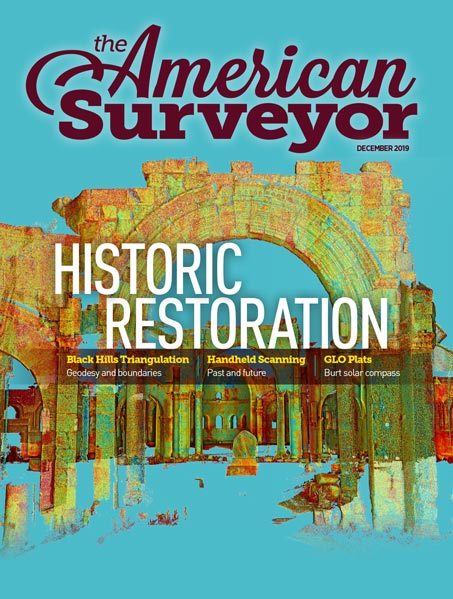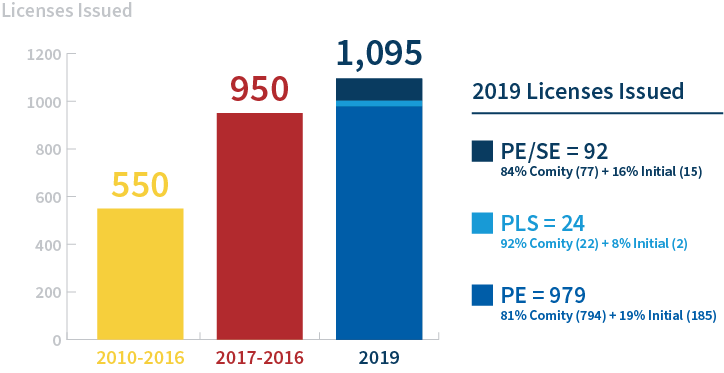CHAIRWOMAN'S MESSAGE

Ms Purcell was elected by the state board to serve as chairwoman effective July 1, 2019. She was initially appointed to the board by Governor Brian Sandoval July 1, 2015. Governor Sandoval reappointed Karen, July 1, 2018, to serve her second three-year term.As we move into 2020, it’s an exciting time for me to serve as your board chair. 2019 was productive and eventful as we continued making progress in simplifying our processes for licensure, reducing costs, and improving customer experiences. We’ve also embarked on a public outreach program, which I mentioned in our last newsletter. After months of preparation, I’m excited to report that the program will launch this month. The goal of the outreach program is to better communicate with the Nevada public, prospective licensees and other stakeholders to generate awareness of the essential role that engineering and land surveying licensure plays in our daily lives and its significance in safeguarding public health, safety and welfare. Although the board operates publicly, we realize that much of what we do may not be apparent to the public or our licensees. This outreach program is designed to increase that awareness. Our outreach program will shine a light on the amazing things professional engineers and land surveyors do to serve our Nevada communities and highlight our simplified licensing process and faster approvals, expanded mobility opportunities, and educational events.
 But beyond the goals of the program, what we’d really like to communicate to all our constituents– the public, engineers, land surveyors, students, legislature, and the governor–is that we exist to serve all of you. We are YOUR Nevada Board.
So please follow us on social media, and stay tuned for frequent updates, videos, events and facts.
The board welcomes offers to volunteer your time and talents. If you would like to be considered as a guest board member or serve on a board advisory committee, please feel free to send an email to the board office, board@boe.state.nv.us.
But beyond the goals of the program, what we’d really like to communicate to all our constituents– the public, engineers, land surveyors, students, legislature, and the governor–is that we exist to serve all of you. We are YOUR Nevada Board.
So please follow us on social media, and stay tuned for frequent updates, videos, events and facts.
The board welcomes offers to volunteer your time and talents. If you would like to be considered as a guest board member or serve on a board advisory committee, please feel free to send an email to the board office, board@boe.state.nv.us.
A PARADIGM SHIFT
by Jason Foose, PLS ■ A Paradigm Shift from the American Surveyor ■ Volume 16 ■ Issue 10 ■ December 2019
Thank you to Jason Foose, Nevada PLS # 20439, Arizona PLS # 43185, Chairman of the Arizona State Board of Technical Registration, for his well-written article on the Land Surveying Professional. Because we are experiencing similar challenges in Nevada, we appreciate Jason’s willingness to grant Nevada permission to re-print his article

The ultimate judicial function of a surveyor is to help maintain a stable society through artistic measuring of land boundaries. Our most valuable service is keeping the neighbors out of the courtroom. Reasonable individuals and corporations that own land understand the economics of a legal fight. They are happy to employ a land consultant that can work through issues rather than pull the fire alarm and walk away.
The paradigm shift begins with adopting logic that neighbors only need one surveyor to resolve their issues and without litigation. This means our contracts should include verbiage that addresses resolution as a necessary part of the completed survey. We are well poised to assemble the evidence and guide the concerned parties cohesively to resolution before we finalize our survey. A strange phenomenon occurs when a lawyer is approached by an upset client. The client’s attitude and pocketbook trigger the lawyer’s “fight or flight” switch. Surveyors have adopted a binary switch as well. It flips between 1.) “I’m right/you’re wrong” and 2.) “That’s just a big ol’ mess out there, see ya later”. Can you see how the surveyor’s response professionally trips the lawyer’s trigger? Land owners view both surveyors and lawyers as costly but necessary evils. With those binary options who wouldn’t?
An important metric here is the definition of “fulfillment of services”. What are your services? Well, we know the courts have shown that deed staking doesn’t necessarily rise to the level of an accurate boundary survey. Conversely, harm is manufactured when the surveyor confuses ropes for robes and tries to self-adjudicate the boundary. When conflicting evidence emerges during the survey the most probable wrong action is to assert our professional opinion and walk away. Our services are uniquely paid for by one party but serve the adjoining owners including the public rights-of-way and overall cadastre. All of these interests have an authoritarian stake over our services. Are the stakeholders being addressed through your services?
A paradigm shift in the business model is on the horizon
The science of measuring has been automated. Just about everyone can physically perform measurements on a cadastral scale. The great postwar era “land development booms” that fueled construction surveying service companies finally died in 2008. Providing billable topo staking services is no longer a hot commodity in the world of UAV mapping, Lidar and machine control. The courts are screaming at us to understand that boundary retracement surveying includes more than just measuring. The delineation between a service business and a professional practice lies within the expectations of the contract. A service business delivers a negotiated quantity. Conversely the professional practitioner guides the client to remedy. A stable land cadastre requires maintenance. The fundamental operation is recovering evidence of the original marks and putting them to paper. If this retracement survey reveals serious conflict or abrasion with the owner’s actions, beliefs, or record then the owners as adjoiners have an opportunity to resolve or live with the discrepancy and a boundary survey can truly be finalized and recorded in perpetuity. The professional service lies within organizing impartial information and documenting the adjoiner’s authoritative resolution of the boundary. The economics of acquiescence may appeal to reasonable and corporate interests. Formalizing acquiescence or the adjoiner’s lawful resolution is a prerequisite to completing a boundary survey and maintaining the stability of a healthy cadastre. Providing the service of a collection of abrasive measurements is nothing more than a pig in a poke. The paradigm shift occurs when the professional awakens to this true function.
REMINDER ON THE REGS - NAC 625.545
As highlighted elsewhere in this newsletter, we are seeing an increasing number of new professionals joining the ranks in Nevada. Since the start of the economic recovery in Nevada, the year on year increase has been moving upward to where the annual number of new Nevada licenses issued (initial and comity) is nearly 1,100. With the number of new licensees performing professional services in Nevada increasing, and an increasing number re-instating their Nevada licenses, it is important to remind those delivering services of the written contract requirements of Nevada Administrative Code 625.545.
The written contract regulation was added in 2010 to prompt a clear understanding between the professional and public as to exactly what services are to be provided along with a cost framework and delivery timeline. Prior to adding this regulation, the board had a sizeable number of complaints relating to disputes between licensees and clients as to work that was actually to be performed. Although not all issues have been eliminated, public complaints relating to clarity in scope of professional services have been significantly reduced.
As stated in the regulation, before performing any work in Nevada – regardless of project size – professionals are required to enter into a written contract with their client. The contract is to include:
- provisions specifying the scope of work to be performed;
- the cost for the completion of the work;
- an anticipated completion date of the work; and
- disclosure on maintaining professional liability insurance.
As mentioned in previous newsletters, NAC 625.545 was amended effective December 10, 2018 requiring licensees to disclose if they currently (at the time of contracting) maintain a policy of professional liability insurance. A policy is not required by regulation but informing a client (in writing) whether a policy is currently maintained is a requirement.
Below is a linked to the amended regulation on the Nevada board’s website – https://nvbpels.org/pdfs/R_085-18_V3.pdf
With any questions regarding Nevada Administrative Code chapter 625 or Nevada Revised Statutes chapter 625, please don’t hesitate to contact the board office at board@boe.state.nv.us or 775.688.1231. Or connect via Twitter, Facebook or LinkedIn.
NEVADA BY THE NUMBERS
After averaging 550 new professional licenses issued per year from 2010 to 2016, as the state emerged from the recession in 2016, licensing numbers increased by a whopping 73% to average 950 in 2017 and 2018. The growth spurt continued in 2019 with a further 15% uptick to just under 1,100 new (initial + comity) professional licenses granted in the calendar year.
The graph here shows the breakdown of initial (first ever professional license in any state or jurisdiction) and comity (first Nevada professional license, currently holds a professional license in another state or jurisdiction) for each license type.

DID YOU KNOW?
Since 2005, Nevada engineering licensure applicants have been able to take the licensing examination any time after receiving their engineering degree.
Applicants do not need to wait until they have four years of experience to take the licensing exam. An applicant still needs to meet all requirements when applying for licensure—education, experience, fundamentals exam (FE), and professional practice exam (PE)—to get licensed. But there is no longer a requirement to wait until an applicant has four years of engineering experience to take the PE licensing exam.
In 2005, Nevada led the way in early exam taking, 15 years later, there are 15 states that now allow early exam taking. To help other states make the change, Nevada shared its exam taking data which showed pass rates were nearly identical for those that took the exam early, to those that took the exam with four or more years of experience. And, there has been no demonstrated downside, but several upsides, including removing a barrier to licensure for those unable to take the exam due to leaving the work force prior to completing their four years of engineering experience. So please share this information with your young engineers and encourage them to take the PE exam as soon as they feel they are ready.
Updates were made to Nevada regulations in January 2019, and those updates might affect you:
- Only licensed structural engineers can design essential facilities such as fire stations, schools, or hospitals. Essential facilities are buildings or structures classified as a Risk Category IV in accordance with the International Building Code.
- For written contracts, professionals must include a disclosure pertaining to professional liability insurance.
- Clarifying language was added related to electronic submittals and digital signatures.
- Eliminated “brick and mortar” requirement. No longer is it a requirement to have a Nevada office with a full time professional physically present in each office to offer and provide services. You still need to have a full-time Nevada professional engineer to offer engineering or a full-time Nevada professional land surveyor to offer surveying, but you don’t need to have an office or a professional physically present in every office.
The board is currently undertaking a comprehensive review of Nevada Revised Statute 625 and Nevada Administrative Code 625 to identify and remove obsolete language and make updates to improve the licensure process and eliminate any unnecessary barriers to work in Nevada.
Our goal is to align as much as possible with the Governor’s economic development initiatives while retaining our duty to safeguard the public.
Here’s a link to the updated regulations—https://nvbpels.org/pdfs/R_085-18_V3.pdf. Please feel free to contact us if you need more information or if you have input on future changes to laws or regulations at board@boe.state.nv.us or 775.688.1231.
ORDERING STAMPS
A quick note to inform the board office is no longer an intermediary between licensees and professional engineer/professional land surveyor stamp vendors. On review, involving the board office as a step in the stamp procurement process doesn’t add any value and results in additional time between a licensee’s order and delivery. In the interest of efficiency, the licensee is to contact their vendor of choice to purchase a stamp.
Examples of the required Nevada stamp design is available for download on the board’s website – in the “Forms” section – https://nvbpels.org/pdfs/NV-Stamp-Seal-Information-REVISED-Feb-2019.pdf
NCEES LOOKING FOR VOLUNTEERS

NCEES is seeking licensed agricultural and biological engineers to participate in an online survey as part of the professional activities and knowledge study for the PE Agricultural and Biological Engineering exam. This survey will be used to update the specifications for the exam. The information is posted online at https://ncees.org/ncees-seeks-agricultural-and-biological-engineers-professional-expertise-and-advice/.
Thank you for your help with this important study.


